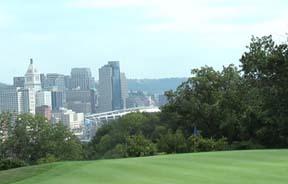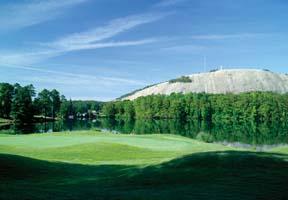
With the challenges facing professional turf managers today, selecting the proper turfgrass variety has become more important than ever.
That statement might sound elementary, but stricter maintenance standards coupled with what seems to be more regular patterns of
irregular weather have altered growing environments in many areas making some varieties more susceptible to disease, or even resulting in new diseases entirely. Add in the plethora of ever-expanding choices in turfgrass varieties and picking the right one for a specific environment can be a daunting task.
"There are so many things for a superintendent to keep track of," said Anthony Williams, CGCS at Stone Mountain Golf Club near Atlanta. "The question of do you have the right grass on your greens is coming to the forefront."
A recent trend of warmer-than-average conditions year-round particularly hotter overnight low temperatures in the summer has increased the boundaries for Bermudagrass use. That is especially true in the transition zone, of which it is said conditions are just right to grown cool-season and warm-season grasses equally poorly.
"In a number of situations there is no ideal grass," said Larry Stowell, Ph.D., of PACE Turf, a San Diego-based research and consulting firm. "That is the tough part."
The transition zone is a veritable Heinz 57 of turfgrass varieties. The Cincinnati Bengals recently installed a sodded Bermudagrass practice field adjacent to Paul Brown Stadium, while one mile away across the Ohio River in Covington, Ky., superintendent Ron Freking grows bentgrass greens and zoysia fairways at Devou Park Golf Course.
Karl Danneberger, Ph.D., of Ohio State University says the trend of warmer temperatures is pushing Bermuda use on golf courses northward as well.
"That's been another trend, looking at surfaces as you move further north, people are using ultradwarf Bermudas into greens, and it's up into Tennessee," Danneberger said at OSU's recent Spring Tee Off educational forum. "I'm kind of curious who will be the first golf course (as far north as) Cincinnati to try it."
While the potential boundaries for Bermudagrass use might be edging northward, it also, as strange as it might sound, is creeping southward in areas once dominated by bentgrass putting surfaces.
In fact, converting from bentgrass to an ultradwarf Bermuda species has been a trend on golf courses throughout the southern transition zone since ultradwarf varieties hit the market in the late 1990s. The most public instance of this was at East Lake Golf Club in Atlanta, where the bentgrass greens struggled under summer conditions considered extreme even by Atlanta standards in the run-up to the 2007 Tour Championship.
After closing for a renovation after the '07 Tour Championship, East Lake reopened in time for the 2008 event with all new MiniVerde ultradwarf Bermuda greens. Not only is MiniVerde better suited for withstanding Atlanta's hot summer months, research shows it is less prone to disease and more tolerant to stress than many other warm-season grasses due in part to its ability to produce rhizomes in high numbers.
Even when converting from cool-season to warm-season (or vice versa), choosing the correct species is not always a clear-cut decision. There are many questions that much be asked and answered before making a choice.
East Lake superintendent Ralph Kepple first began learning about MiniVerde 10 years before growing it when he attended an ultradwarf management seminar by Clemson's Bruce Martin, Ph.D., and Bert McCarty, Ph.D.
According to NTEP trial results Kepple studied MiniVerde ranked highest for overall turf quality, color and summer density. It also outperformed other ultradwarf varieties in the shoulder seasons for spring green up and fall density, which is important even in the southern reaches of the transition zone. Discussions with other superintendents managing turf in a similar climate confirmed those findings, he said.
While at the seminar, Kepple was moved by a slide that showed the root structure of MiniVerde, which was much longer than that of other ultradwarf varieties. He remembered that slide many years later when it came time for the renovation at East Lake.
"This was the one that really jumped out at me since we were in the middle of a drought," Kepple said. "With longer roots I can water less frequently, and I felt it would be irresponsible to plant a variety that would require more irrigation, given the uncertainty of water availability in Georgia."
The East Lake project has touched off a series of Bermuda renovations all across Atlanta, once a bastion of southern-based bentgrass putting greens.
"The summer of 2007 frightened people here in Atlanta," Stone Mountain's Williams said. "It showed us that even with resources, Mother Nature can knock you out of the bentgrass market."
 Stone Mountain, a 36-hole Marriott Golf facility northeast of town, is one of the few bentgrass holdouts in the Atlanta area, but maybe not for long.
Stone Mountain, a 36-hole Marriott Golf facility northeast of town, is one of the few bentgrass holdouts in the Atlanta area, but maybe not for long.Located inside Stone Mountain State Park, officials there are considering next year converting the greens on the property's Lakemont Course to Bermudagrass while maintaining the Stonemont Course as a bentgrass facility. Although the bulk of the rounds at Stone Mountain are played in the spring and fall, it also must look lush and green in summer when potential customers scout the conference facilities at the park's Marriott hotel.
"If you would've asked me seven or eight years ago, I never would have broached the subject," Williams said. "But there have been too many high-profile successes to ignore.
"I'm not 1,000-percent convinced, but I'm convinced those we compete with have made it part of our market."
The concern for superintendents in the transition zone is what might happen to those Bermuda greens in the event of a severe and prolonged cold winter, like the one Atlantans experienced 40 years ago.
"Bentgrass, in the day, was a finer grass. Now, ultradwarves measure up," Williams said. "The question is if we have two or three bad winters in a row, then what will that mean? No one has had that yet."
Equal consideration must be given to environmental and other stress factors when selecting a turfgrass in other parts of the country as well.
Along the California coast, many courses with Poa annua greens have renovated in recent years in response to infestations of the Anguina Pacifica nematode.
Prior to restoring the Lake Course in advance of the 2012 U.S. Open at The Olympic Club in San Francisco, Pat Finlen, CGCS, brought in Stowell's San Diego-based PACE Turf to make recommendations based on environmental conditions that prevail in the Olympic's oceanfront microclimate such as low sunlight, low soil temperatures, low air temperatures, high salt index and excessive moisture.
In the end, Finlen elected for a 70-30 mix of 007 and Tyee creeping bentgrasses, because of the former's cold tolerance and Tyee's ability to thrive in warmer conditions. The mix, Finlen surmised, would provide balanced coverage. He has since regrassed the greens on the Ocean Course with the same mix.
"They have performed well," Finlen said. "In addition, the 007-Tyee mixture has great ball mark recovery ability, especially in the cool climate we have."
OSU's Danneberger likened the turf-selection process to buying a car.
"Don't put a square peg into a round hole," he said. "It's one thing to buy a nice car, it's another thing to pay to maintain it."
It also is important to recognize that after making the right turfgrass selection, there still will be many challenges ahead.
"There's no silver bullet out there," Danneberger said. "Get the best grass that is adapted for your area and recognize the problems you are going to have."

